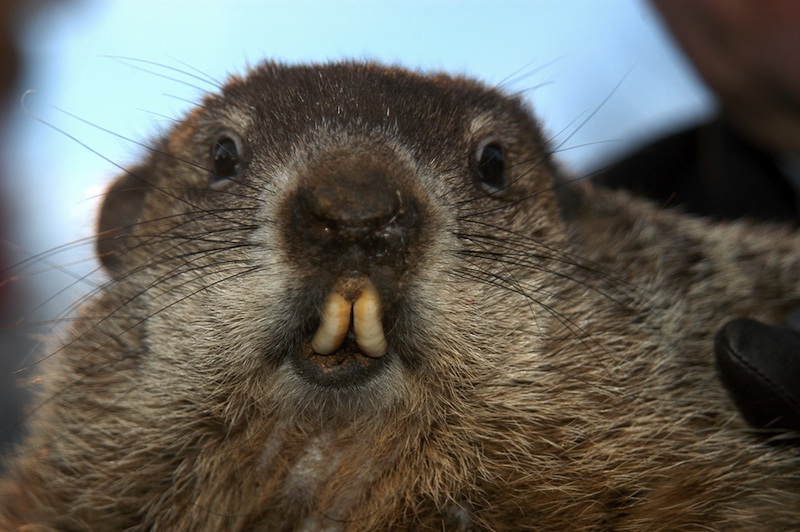Groundhogs on the Menu? The Wild History of Punxsutawney Phil

Punxsutawney Phil may not know it, but groundhogs were part of the menu on Groundhog Day in the late 1800s.
Apparently, groundhogs were the "other white meat" on that day.
These days, Punxsutawney Phil doesn't have to worry about ending up on a dish. Revelers gather in Punxsutawney, Pennsylvania, where they wait with bated breath to see whether Phil sees his shadow, indicating that winter will last six more weeks. If he doesn't see his shadow, there will be an early spring, folklore says. [Supernatural Powers? Tales of 10 Historical Predictions]
In fact, the annual Feb. 2 holiday has roots going back to medieval Europe, according to a 1985 report in the Western Pennsylvania Historical Magazine.
Winter is halfway over when Feb. 2 rolls around. (It marks the midpoint between the winter solstice and spring equinox.) Historically, this day was for "reckoning debts and establishing contracts between landowners and tenant farmers" in medieval Europe, historian Christopher R. Davis wrote in the report.
Moreover, Feb. 2 is also Candlemas, a Christian holiday that remembers when Mary presented the Christ child and had her ritual purification. Those who observe the day receive blessed candles at church.
An old English song ties Candlemas and winter's longevity together, said the Punxsutawney Groundhog Club.
Sign up for the Live Science daily newsletter now
Get the world’s most fascinating discoveries delivered straight to your inbox.
If Candlemas be fair and bright, Come, Winter, have another flight; If Candlemas brings clouds and rain, Go Winter, and come not again.
A Scottish rhyme has a similar message, the club said:
If Candlemas day be dry and fair, The half o' winter to come and mair, If Candlemas day be wet and foul, The half of winter's gone at Yule.
The two verses basically say the same thing — that if the weather is sunny on Feb. 2, winter will linger awhile longer. But if it's cloudy on that day, winter is on its way out.
Candlemas transformed into the American Groundhog Day in the 1800s, when German immigrants settled in Pennsylvania, the report said. People tended to use badgers as their weather prognosticators in the old country, but groundhogs (also known as woodchucks, marmots or whistle-pigs) were plentiful in Pennsylvania, and so a switch was made.
Unfortunately for the woodchuck (Marmota monax), it also tasted good.
"Dinner guests were reportedly pleased at how tender the marmot meat was when properly prepared, tasting like a cross between pork and chicken," Davis wrote in the report.
Groundhog Day officially began on Feb. 2, 1886, said Katie Donald, the executive director of the Groundhog Club. Nowadays, the celebration lasts four days, and it garners worldwide attention, largely thanks to the 1993 blockbuster film "Groundhog Day" starring Bill Murray.
Officials claim that Punxsutawney Phil is 130 years old, but groundhogs typically live for about 6 years in the wild, according to Professional Wildlife Removal.
When Phil isn't showing off his celebrity on Groundhog Day, he lives in an enclosure with his wife, Phyllis, and a few of other groundhogs. But he also partakes in other events, including parades, festivals and sporting events, and visitation days at elderly care facilities and schools, Donald said.
"He enjoys meeting new friends from all over the world," Donald told Live Science in an email. "He generally is very mild-mannered."
Chilly but partly sunny weather is expected for the historic 130th Groundhog Day celebrations in Punxsutawney, Pennsylvania, tomorrow. Check back on Live Science to see whether the groundhog will get the forecast right this year.
Follow Laura Geggel on Twitter @LauraGeggel. Follow Live Science @livescience, Facebook & Google+. Original article on Live Science.

Laura is the archaeology and Life's Little Mysteries editor at Live Science. She also reports on general science, including paleontology. Her work has appeared in The New York Times, Scholastic, Popular Science and Spectrum, a site on autism research. She has won multiple awards from the Society of Professional Journalists and the Washington Newspaper Publishers Association for her reporting at a weekly newspaper near Seattle. Laura holds a bachelor's degree in English literature and psychology from Washington University in St. Louis and a master's degree in science writing from NYU.









